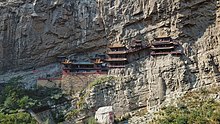| Hanging Temple | |
|---|---|
悬空寺 | |
 The Hanging Temple. | |
| Religion | |
| Affiliation | Buddhism |
| Location | |
| Location | Hunyuan County, Datong City, Shanxi Province |
| Country | China |
| Geographic coordinates | 39°39′57″N 113°42′18″E / 39.66583°N 113.70500°E |
| Architecture | |
| Style | Chinese architecture |
| Founder | Liaoran |
| Date established | 6th century |
The Hanging Temple, also Hengshan Hanging Temple, Hanging Monastery or Xuankong Temple (simplified Chinese: 悬空寺; traditional Chinese: 懸空寺; pinyin: Xuánkōng Sì) is a temple built into a cliff (75 m or 246 ft above the ground) near Mount Heng in Hunyuan County, Datong City, Shanxi Province, China. The closest city is Datong, 64 kilometres (40 mi) to the northwest. Along with the Yungang Grottoes, the Hanging Temple is one of the main tourist attractions and historical sites in the Datong area. Built more than 1,500 years ago, this temple is notable not only for its location on a sheer precipice but also because as a Buddhist temple it also contains references to the other two of the three Chinese traditional philosophies or religions (三教): Taoism, and Confucianism. The structure is kept in place with oak crossbeams fitted into holes chiseled into the cliffs. The main supportive structure is hidden inside the bedrock.[1] The monastery is located in the small canyon basin, and the body of the building hangs from the middle of the cliff under the prominent summit, protecting the temple from rain erosion and sunlight bake.
- ^ "挂在60米高悬崖上 千年古寺为何悬空不倒". Archived from the original on 2013-04-06. Retrieved 2011-02-13.

